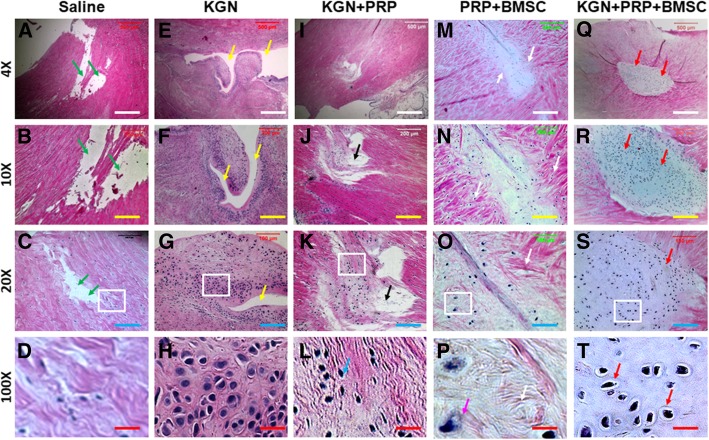Fig. 7.
H&E staining of rabbit menisci after five different treatments for 3 months. a–d The wounded meniscus treated with saline at day 90 post-surgery. e–h The wounded meniscus treated with KGN at day 90 post-surgery. i–l The wounded meniscus treated with KGN-PRP gel at day 90 post-surgery. m–p The wounded meniscus treated with BMSCs-containing PRP gel at day 90 post-surgery. q–t The wounded meniscus treated with BMSCs-containing KGN-PRP gel at day 90 post-surgery. The images of d, h, l, p, and t were enlarged box areas in the images of c, g, k, o, and s, respectively. Large unhealed wound areas were still found in the saline-treated meniscus (green arrows in a, b, c) and KGN-treated meniscus (yellow arrows in e, f, g). Although the wounds were healed with KGN-PRP gels, new formed tissues were thinner than around tissues (black arrow in i, j, k) and less cells in the new formed tissues were fibrocartilage-like cells (blue arrow in l) than the wounds treated with BMSCs-containing PRP gel (m–p) and BMSCs-containing KGN-PRP gel (q–t). There was no unhealed wound area found in the meniscus treated with BMSCs-containing PRP gel (m–p) and BMSCs-containing KGN-PRP gel (q–t); however, the regenerated tissues were different in the wound areas treated with two different BMSCs-containing PRP gels. More collagen fiber-like tissues were found in the wound treated with BMSCs-containing PRP gel (white arrows in m–p), while more cartilage-like cells were found in the wound treated with BMSCs-containing KGN-PRP gel (red arrows in q–t). White bars 500 μm; yellow bars 200 μm; blue bars 100 μm; red bars 20 μm

